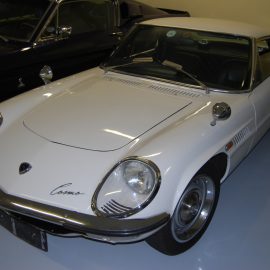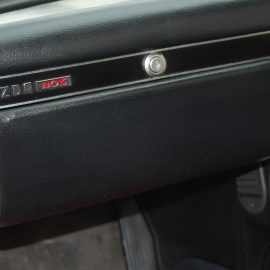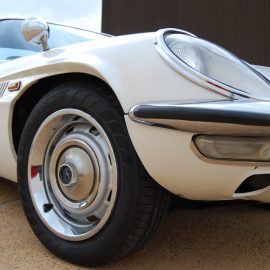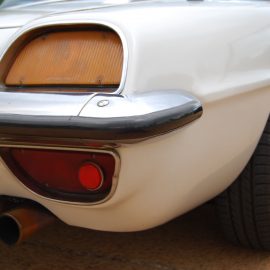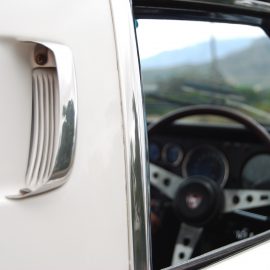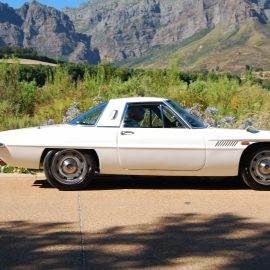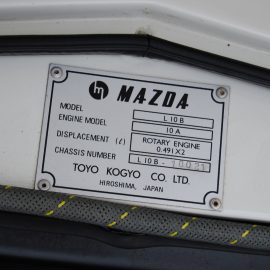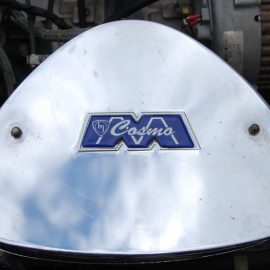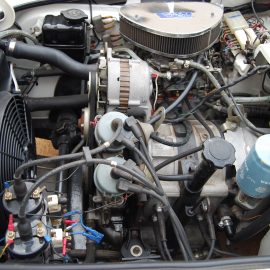
31 Jul Collection In Action: Mazda Cosmo Sport
Designed to showcase the launch of Mazda’s Wankel rotary engine development and hand built in limited numbers, the Cosmo Sport has become a rare and collectible piece of automotive history. Mike Monk delves into its background and drives FMM’s rare and well-kept example…
Since the 1960s, Mazda has done what no other motor manufacturer ever managed to do, namely make the Wankel rotary engine work as a volume production engine. NSU was the first company to bring to market the then revolutionary powerplant, initially in single-rotor form for the Spider (1964-67), and then in twin-rotor guise for the ill-fated Ro80 saloon (1967-77), but major unreliability issues signalled the death knell for the forward thinking German company. While this was going on, Toyo Kogyo (the holding company’s name before it became Mazda) president Tsuneji Matsuda hired an engineer named Kenichi Yamamoto to develop a car to compete with Japan’s fast rising and dominant auto makers Toyota and Nissan. The car, the R360 Coupé, sold well but something more was needed to prevent the company from being bought out in what was at the time a post-Hiroshima industrial revolution.
Matsuda had heard of the Wankel engine development, went to Germany and despite being made aware that the concept was not fully developed, handed over a huge sum of money to obtain a licensing agreement and tasked Yamamoto with putting it into production. However, the engineer soon came to realise just how under-developed the Wankel actually was and despite his best efforts to turn it into a production reality, the extent and the seriousness of the problems proved too much for Yamamoto to conquer, forcing him to visit his boss to admit defeat. But to the surprise of everyone, Matsuda talked him around and Yamamoto went away rejuvenated to form a group of 47 engineers – that became known as the Rotary Warriors – to still make the president’s vision a reality.
Some five years on, and the Warrior’s dedicated efforts had overcome the odds and the Mazda rotary was ready for the road – but not in some humdrum saloon but rather a characterful coupé, the prototype of which appeared in 1963 and was labelled Project L402A. Two such cars were built, fitted with an 8A version of the rotary, and a third model, with a 10A-spec engine, was driven by Matsuda to the Tokyo Motor Show in October 1964. Commencing in January the following year, 80 so-called pre-production cars were built – 20 for Mazda’s test department and the rest to dealers for evaluation and testing – before the Series 1 Mazda Cosmo 110S was officially launched in May 1967.
The Cosmo has distinctive styling that eschewed trends of the time inasmuch that it avoided the phallic long bonnet/short rump proportions of the Jaguar E-Type, Toyota 2000 and Nissan 240Z for a similar-length bonnet/cockpit/boot profile that give it a less butch appearance. The cowled headlamps, fender vents, body side swages, flat-topped rear wheelarches and two-tier tail-lights are just some of the touches that add character to the overall shape.
The 110S was powered by a two-rotor engine dubbed 10A/0810 having a displacement of 982cc (491cc x 2) that produced 110 hp (82 kW) – hence the 110 name – at 7 000 r/min, and 130 N.m of torque at 3 600, outputs that were nevertheless thought to be optimistic. It used an Hitachi four-barrel carburettor and an odd ignition design – two spark plugs per chamber with dual distributors. Transmission was a four-speed manual and 14-inch wheels were standard. Brakes were unassisted, with 254 mm discs up front and 201 mm drums at the rear.
Claimed performance figures were 16,4 seconds for the quarter-mile sprint and a top speed of 185 km/h. Mazda entered two practically stock Cosmos in the 1968 84-hour Marathon de la Route, which started and finished in Liege, Belgium but took in an 84-hour race at the Nürburgring. One car retired with axle damage in the 82nd hour but the other went on to finish fourth overall – a highly impressive achievement.
Series 1 production lasted just over a year with 343 examples built before the Series 2 Cosmo Sport was introduced in July 1968. Visually, the car had a larger air intake under the front bumper supplemented by smaller intakes either side, 15-inch wheels were fitted and the wheelbase had been stretched by 381 mm to increase cabin space and improve the ride. A five-speed gearbox was standard and the brakes were given power assistance. Improvements under the bonnet included an 10A/0813 engine that delivered 130 hp (97 kW) and 140 N.m of torque, which helped reduce the quarter-mile time to 15,8 seconds and raise top speed to over 190 km/h.
But production continued to be by hand at the rate of around one per day, and when Series 2 production ceased in September 1972, just 1 176 examples had been manufactured, realising a total build of 1 599 units – all of which, incidentally, were right-hand drive. But the Cosmo had done its job of showcasing Mazda’s belief in the Wankel concept and the company’s ability to triumph over adversity. An example even appeared in a highly popular Japanese superhero series called The Return of the Ultraman. But with so few built, the car was an instant rarity and slowly emerged as a serious collector’s item.
Two are known to exist in South Africa, and the Franschhoek Motor Museum acquired a 1968 Series 2 model from Deon du Plessis, who had a long association with the old Heidelberg Motor Museum in Gauteng, which was bought up and relocated to the Cape to form the basis of FMM. Deon found the car at a second-hand dealer in Greylingstad. All Cosmos were painted white but this one had been resprayed in yellow. Deon restored the car to its original colour scheme and little other work was necessary it seems – the dry Highveld weather having helped preserve the bodywork. However, the motor needed fettling and it was sent to Cape Town’s ‘Mr Rotary’, Peanuts Fouche, to rebuild. But parts are extremely hard to come by, so a later (post-May 1970) 12A engine has been fitted for the meantime. The 12A has the same diameter but deeper rotors than the 10A’s, which raised each one’s displacement to 573cc for a total of 1 146cc. As an aside, American talk show host and auto aficionado Jay Leno has one of only six Cosmo Sports imported to the USA, and his car is also running a 12A engine.
What did not change throughout the car’s life was the suspension layout, with upper and lower A-arms/coil springs plus an anti-roll bar set-up at the front and a live rear axle located with trailing arms, a De Dion tube and supported on semi-elliptic leaf springs.
Inside, the facia is comprehensively equipped with a speedo and rev counter plus gauges for fuel, amps, oil pressure and water temperature as well as a clock. The angled steering wheel has three drilled-aluminium spokes and a thin wood rim, which was period sports car fare. A single column stalk to the right operates the indicators. The upright handbrake on the side of the transmission tunnel has an exposed ratchet, which also adds a sporty touch although anyone as long-legged as me battles with knee clearance between the wheel rim and the top of the lever as fore/aft seat movement is limited despite the lengthened wheelbase. Behind the seats is a useful storage shelf.
Firing up the motor and that distinctive whine instantly brings back memories of Mazda rotaries driven in the past. Dip the clutch and the stubby gearshift engages the cogs with a firm, precise action and I am soon revelling in what is an instantly enjoyable classic sports car. Despite its relatively large diameter, the rack and pinion steering is direct, needing little correction around the straight ahead and the ride is comfortably firm. Once warm, the motor revs with inherent eagerness, accompanied by that oh-so-evocative exhaust. Thin front pillars provide a panoramic view and the Cosmo simply encourages the driver to press on safe in the knowledge that the handling is well capable of confident high-speed cornering. I like this car for its character, uniqueness and smile-inducing manners.
Older citizens may well remember Mazda’s 1970s local advertising jingle about engines that “go around and around, not like pistons that go up and down”. The Wankel motor did not revolutionise the world’s auto industry but Mazda made it work, even to winning at Le Mans, the only Japanese company to do so and, pointedly, with the only rotary-powered car to cross the finish line first. And it all started with the Cosmo…
Visitor Note: The Mazda Cosmo Sport is currently on view in Hall D.
(While certain lockdown restrictions still apply on movement and accessibility, this story is based on my article that first appeared in the Apr/May 2012 issue of Classic & Performance Car Africa magazine – MM.)




